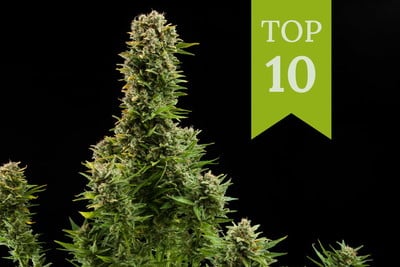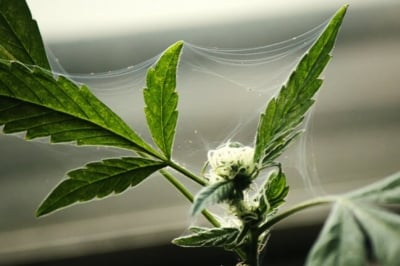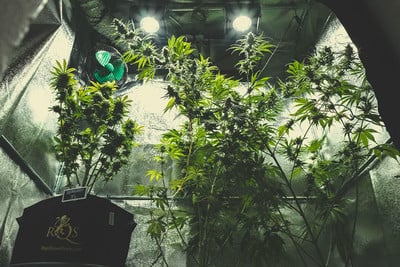.
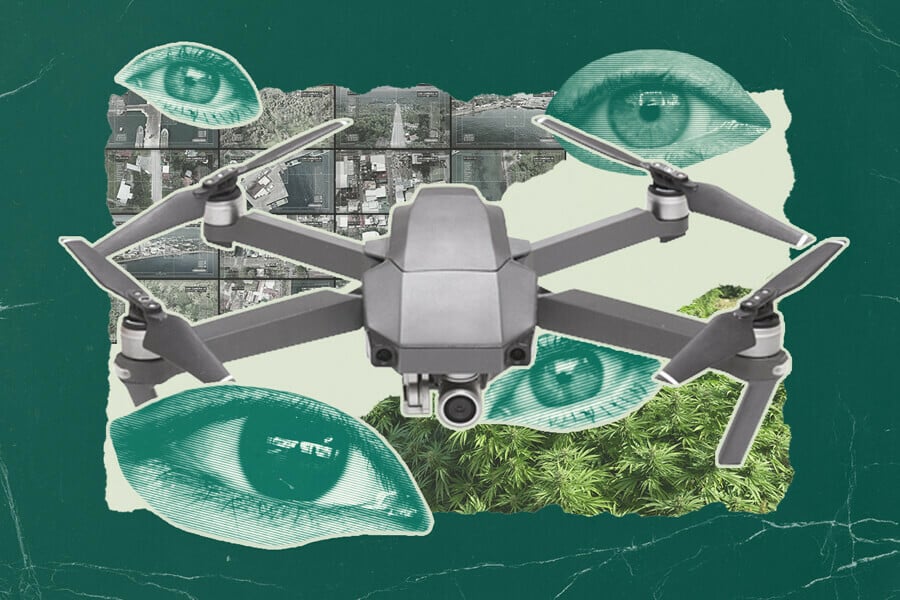
Is Drone Surveillance a Problem for Outdoor Cannabis Cultivation?
Growing cannabis comes with many challenges, especially when cultivating the herb in areas still under the weight of prohibition. Here, detection by police air surveillance looms as a constant threat. Discover exactly how these systems work, what their future looks like, and what some outdoor cannabis growers do to avoid them.
Contents:
- A look at air surveillance and its impact on cannabis cultivation
- The history of air surveillance in cannabis detection
- Can air surveillance detect outdoor weed growing operations?
- Strategies to minimise air detection when growing weed outdoors
- The future: drone surveillance for cannabis detection
- Air surveillance: a burgeoning problem for outdoor weed growers
The threat of detection via air surveillance has long troubled indoor cannabis growers in areas facing prohibition. Helicopters equipped for finding growing operations look for various clues to uncover illicit activity, including heat signals. However, with the technological landscape changing so quickly, the comfort that outdoor growers once took in isolated locations, camouflage, and other stealthy techniques is starting to wane.
With the advent of advanced drone technology and artificial intelligence, many outdoor growers are thinking of new ways to keep their plants veiled. Let’s explore the current state of cannabis air surveillance, its impact on growers, and strategies that could help to mitigate the risk of discovery.
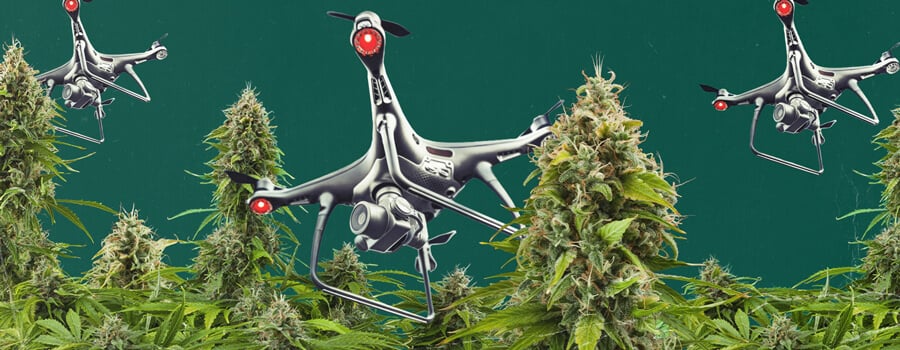
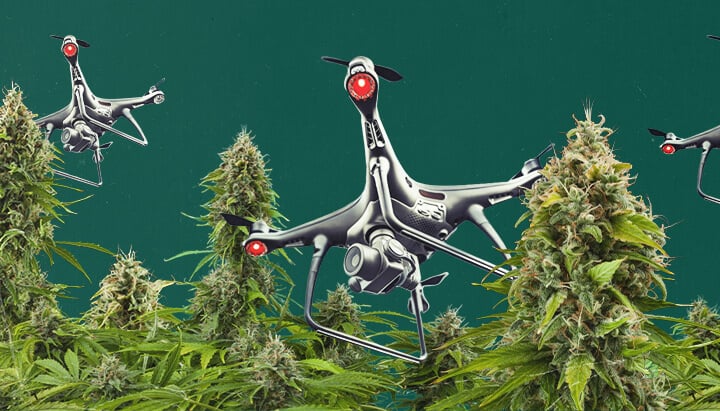
A Look at Air Surveillance and Its Impact on Cannabis Cultivation
While more and more countries are embracing cannabis legalization, countless growers across the world still face the threat of prosecution for growing the herb. Law enforcement agencies use air surveillance as a primary tool to bust both indoor and outdoor growing operations. While outdoor farms are typically harder to spot, indoor grows emit signature signs that make them ripe for the picking.
Though air surveillance has resulted in many arrests, innovative growers are constantly coming up with ways to avoid aerial detection. Continue reading to discover the basics of air surveillance technology, how it works, and the history of its application in hunting down cannabis grows.
-
The Basics of Air Surveillance Technology
Air surveillance to detect cannabis growing operations involves the use of different aircraft equipped with specialized optics and imaging systems. The types of aircraft differ from region to region, with small planes proving more useful across large, open expanses, and helicopters coming out on top in densely populated and built-up urban areas.
Aircraft have the obvious advantage of rapid travel and a scoping point of view. On top of this, they provide the element of surprise and can overcome the physical barriers that crews on the ground may encounter, from fences to locked doors. Specialized systems fitted into both planes and helicopters allow operators to get up close and personal with suspected growing sites, despite being up high in the air. Both zoom cameras and heat-detection optics are highly effective at detecting plants themselves, as well as the tell-tale signs of cannabis cultivation.
-
How Air Surveillance Detects Indoor Cannabis Grows
Police helicopters don’t possess x-ray imaging devices and therefore can’t see through walls. However, the use of forward-looking infrared (FLIR) cameras allows crews to detect heat signatures from indoor cannabis operations. This technology works by detecting and measuring infrared energy emitted from buildings used to grow cannabis on varying scales. Because these operations often run complex lighting systems, they generate more heat than the surrounding houses. FLIR cameras look for buildings that contain one or multiple rooms that have a higher heat signature than the rest of the house. They’re also used to detect hot air expelled by vents outside of the building.
On top of this, helicopters can also use simple visual cues. In cold regions, buildings with no snow on the roof in otherwise snow-covered towns or cities are a telltale sign of illicit cannabis cultivation.
The History of Air Surveillance in Cannabis Detection
Law enforcement agencies have long used aircraft to hunt down cannabis-growing operations. A document[1] titled “Aerial Surveillance To Detect Growing Marihuana”, published by the United States Department of Justice in 1983, states that “The best surveillance aircraft is the single-engine, high-winged, fixed-gear plane, such as the Cessna 172”. The document goes on to detail the best ways to visually detect cannabis from the air.
Helicopters have become a typical means of scouting out potential growing sites in urban areas. However, the technology for this purpose has rapidly evolved in recent years. Drones equipped with thermal imaging are now a big cause for concern for indoor cultivators. Police in the United Kingdom used a drone equipped with thermal imaging technology to bust a grow[2] consisting of over 150 plants.
Can Air Surveillance Detect Outdoor Weed Growing Operations?
Most outdoor growing operations don’t use powerful lights. Many of them are also tucked away on rural properties or out in forest clearings or other hidden places. Therefore, these efforts aren’t prone to detection from aircraft with heat-sensing technology onboard. However, police forces across the world use various devices to scout out cannabis operations from the air.
Air surveillance operatives look for certain clues that help them distinguish cannabis plants from nearby vegetation. However, spotting cannabis by color alone from the air is only possible when looking for large amounts of plants in relatively arid environments. Aircraft crews are also instructed[3] to look out for gardens that are growing in unlikely areas where things appear out of the ordinary. Flights also patrol at certain times of the day and year to increase the likelihood of spotting an operation. Flying at heights of 150–250 metres maximises their chances.
Crews also aim to take off in the morning when cannabis plants have a fresh and radiant appearance, and also position the aircraft between the sun and the plants to improve visibility. Flights mostly occur during July and August when plants are maturing, and the use of cameras with zoom lenses helps to reduce any guesswork.
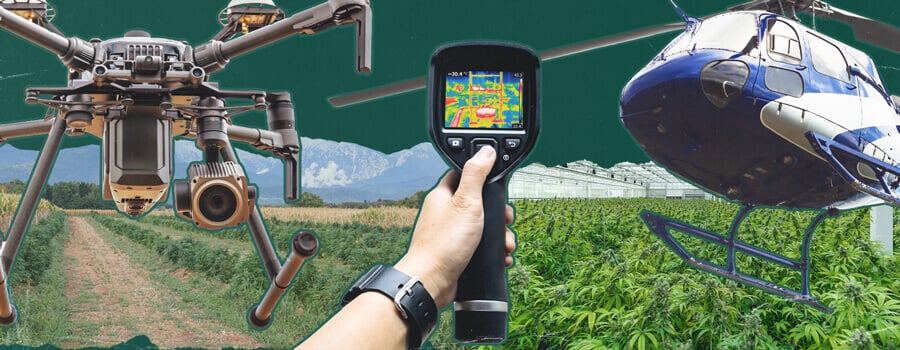
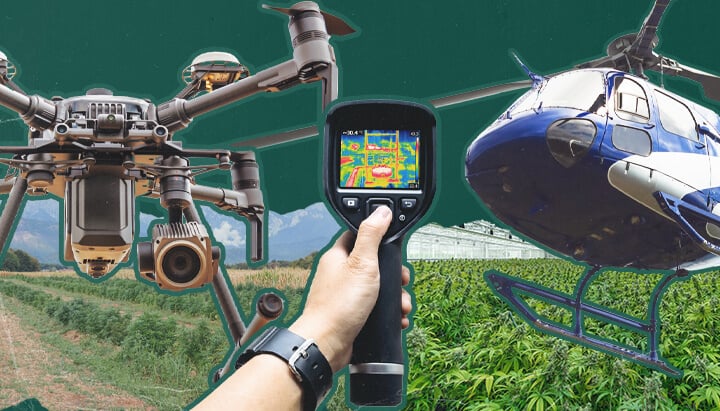
Strategies to Minimise Air Detection When Growing Weed Outdoors
Outdoor weed plants certainly aren’t immune to detection from police helicopter surveillance, planes, or drones. So, what exactly can outdoor cultivators do to increase the odds of hiding their plants from aerial detection?
-
Choose Strains Less Detectable by Air
Not all cannabis strains are the same size, and simple logic tells us that smaller plants are harder to spot from the air than larger ones. If you’re looking to keep your outdoor grow as stealthy as possible, it makes sense to select smaller strains. Furthermore, training them with techniques such as LST will further limit their size. Using autoflowering genetics will also drastically reduce the time your plants spend in the ground. In comparison, some sativa-dominant photoperiod cultivars can reach heights of 300 cm with large, sprawling canopies, making them much more vulnerable to aerial detection. Not only that, but they take much longer to mature, exposing them to potential detection over a greater period.
-
Implement Camouflage Techniques
Many outdoor growers choose to employ camouflage techniques to help their plants blend in with the surrounding environment. Brown and green netting and shade cloth work well to hide plants without drawing any attention. These materials let enough light through to keep plants thriving while disguising their obvious appearance. While they work well to keep plants hidden from aerial detection, they can have the opposite effect on ground level. If you’re going to use this approach, do so in the context of a small growing operation consisting of only a few plants.
-
Embrace Polycultures
Polycultures refer to numerous species of plants growing side by side in harmony. Not only does this method of growing make cannabis plants much harder to spot from the air, but it helps to improve both plant and soil health. Polycultures improve the soil microbiome, limit the spread of pests and diseases, and also offer harvests in the form of culinary herbs, vegetables, and fruits. Instead of growing in obvious rows, consider creating more of a chaotic polyculture that doesn’t have a human fingerprint from the air.
-
Time Your Cultivation to Avoid Detection Peaks
Police helicopters, planes, and drones frequent the skies looking for cannabis from June to August. You can time your growth accordingly so that your plants spend as little time maturing in these detection peaks as possible. Again, aim to use autoflowering genetics, which finish much sooner and can be grown at essentially any time of year (weather permitting). Start them earlier in the growing season with the help of a greenhouse or polytunnel, and you’ll harvest just as the peak detection period swings around.
-
Keep Your Operation Small
It goes without saying that you should keep your growing operation as small as possible. Never grow more than you need for your own personal stash if you face a heightened risk of aerial detection in your area. Large groups of plants, big polytunnels, and sprawling gardens are much easier to spot from the air.
The Future: Drone Surveillance for Cannabis Detection
Helicopters and planes have had relative success in busting cannabis operations over the last couple of decades. However, the success of police forces in this area is likely to increase exponentially in the near future with the advent of advanced drone technology and artificial intelligence.
Going forward, it’s highly likely that squads of small drones piloted or assisted by AI will make it easier than ever before to hunt down cannabis crops. While this prospect might send many growers indoors, we’re likely to see innovative outdoor cannabis growers create new ways to combat this emerging technology.
Air Surveillance: A Burgeoning Problem for Outdoor Weed Growers
Air surveillance isn’t an exclusive threat to indoor growers. However, outdoor growers have a suite of strategies at their disposal to keep crops hidden, from camouflage and polycultures to timing when they sow. While these often work, growers will need to come up with new, dynamic ways to avoid AI drones and other technological advances in the domain of aerial detection.
- Aerial Surveillance To Detect Growing Marihuana | Office of Justice Programs https://ojp.gov
- Thermal image drone helps bust cannabis farm harvesting 150 plants in Hendon https://www.itv.com
- Aerial Surveillance To Detect Growing Marihuana | Office of Justice Programs https://ojp.gov


























